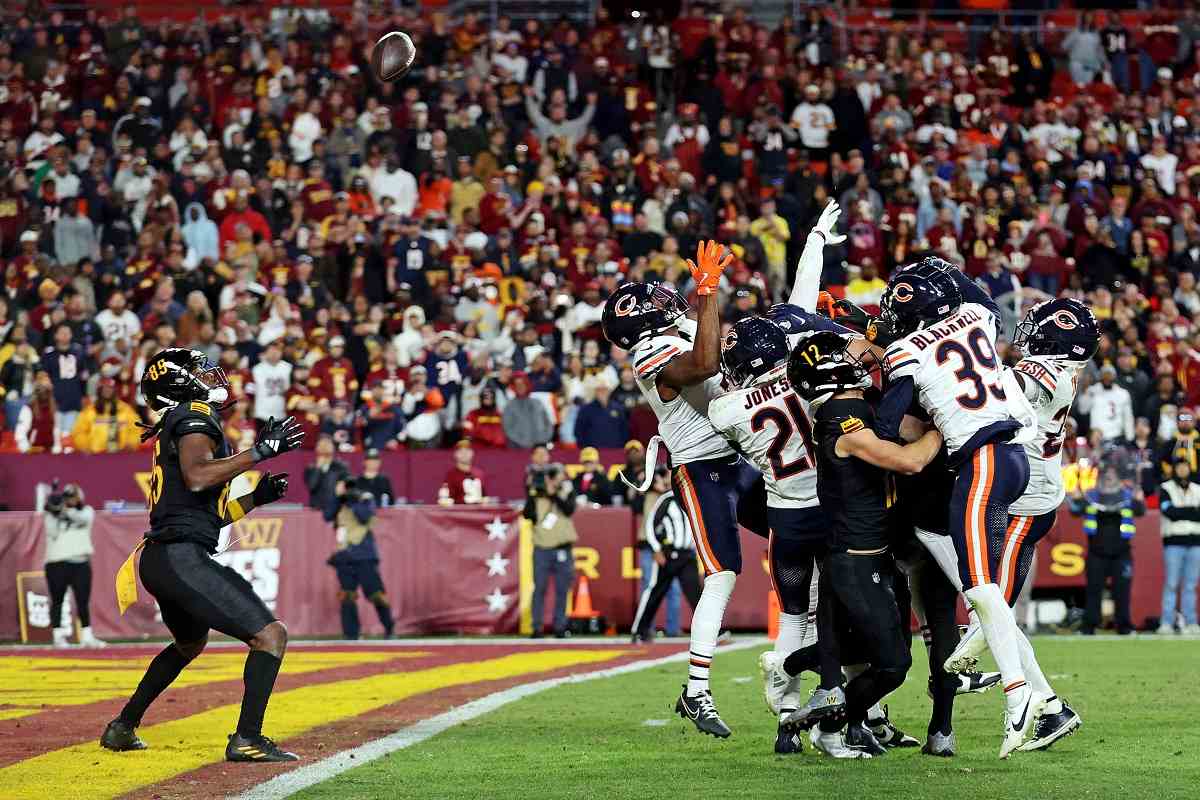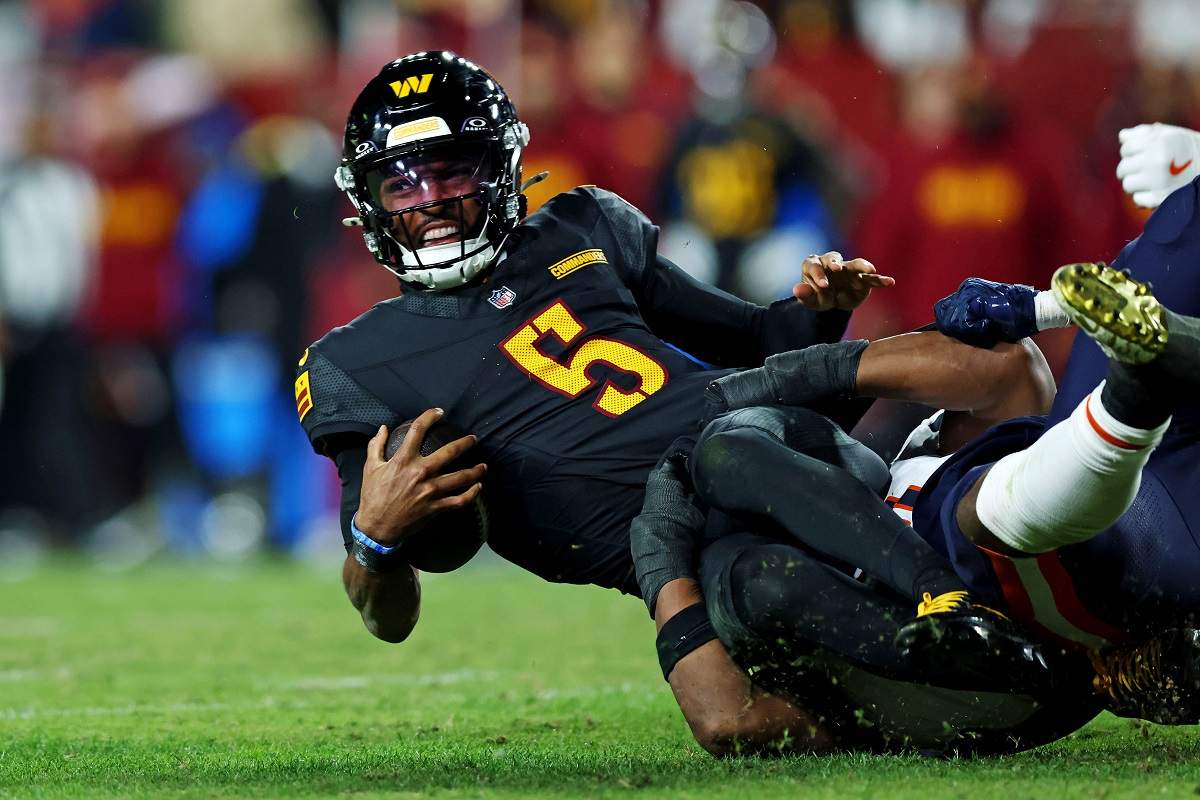
Oct 27, 2024; Landover, Maryland, USA; Washington Commanders wide receiver Noah Brown (85) catches a Hail Mary pass that was tipped with no time left to beat the Chicago Bears at Commanders Field.

Oct 27, 2024; Landover, Maryland, USA; Washington Commanders quarterback Jayden Daniels (5) reaches for a first down but is short during the fourth quarter against the Chicago Bears at Commanders Field.
13:09 JST, October 29, 2024
Certain people are better at making “rainbows in the mind” become real, in the words of psychologist C.R. Snyder, and Jayden Daniels and his teammates are among them. There was nothing airy about the action and the tumult of those final two seconds from the Washington Commanders on Sunday. So many things had to go right, long before Noah Brown ever caught that perfectly lofted ball from Daniels. They worked for that play, they had confidence in it, and they deserved to score.
There is a school of psychology called “Hope Theory,” and it was the specialty of Snyder, a late professor and researcher at the University of Kansas, who described hope not as some sappy, breezy optimism but rather the experience-firmed belief that you have “agency” and an “actual pathway” to solving a difficulty. Certainly, there had to be a combination of good luck and fortunate incompetence by the Chicago Bears, but they weren’t the main factors, not by a long shot. Not when you review the play and break it down. Washington’s hope was based in solids, not dreams.
“When you go back and rewatch the play, everyone was working their a– off,” running back Brian Robinson Jr. said late Sunday, “doing everything they needed to do for that last play, just to get that ball up and see what happens.”
First of all, they had practiced it. Repeatedly. Coach Dan Quinn had drilled them on it at least a dozen times, so it was no accident that the four receivers made a diamond formation, right where they were supposed to be and visible to Daniels despite the cluster and scrum in the mouth of an end zone filled with Chicago defenders. When asked what he saw out there, Terry McLaurin answered crisply, “I saw a team that practices those plays.”
McLaurin added, “Each and every week since DQ had been here, we emphasized the gotta-have-it, winning-moment situations. We didn’t know when it was going to come up, but DQ has been talking about it all week. … We practice that literally a few times a week. And those situations, gotta-have a situation, whatever the situation is, we practice it, so we’re ready.”
McLaurin used an interesting phrase. “We’re ready to be ready for that moment.”
Ready to be ready for the moment – that’s not a bad way of stating the essence of hope theory. Before he died in 2006, Snyder and his colleagues conducted studies with provocative titles such as, “Hope Takes the Field: Mind Matters in Athletic Performance,” which measured clinically how high-hope athletes showed definite advantages. Again, real hope is not merely some rose-colored, unreasonable optimism. Snyder defined it as a cognitive asset made up of two specific components. The first, “pathway thinking,” is a person’s ability to conceptualize avenues toward a problem-solution. It’s the determination to keep looking for a way. The second, “agency,” or agentic thinking, is the ability to recognize how your own sustained work can advance you along that pathway, to get you there. Either, by itself, is not enough. Snyder liked to call them “will power and way power.”
If it still sounds a little woo-woo, consider this work by Snyder: In a study of Division I track athletes, he found that high-hope accounted for a 56 percent difference in performance over low-hopers, even when removing variance for “natural ability” as perceived by their coaches.
Cognitive hope is based in the hard expectation, not an insecure wish, that a certain number of things will go right because you have worked at them. This is what gives the Commanders such a sense of possibility for the first time in years and why they have so flipped the mood in their locker room from “these things don’t happen for us.”
The old Commanders couldn’t trust that something would go right because almost invariably, somebody made a telltale mistake, maybe because there were some paycheck players who lacked real commitment or because they didn’t trust management enough to lay it on the line. Confidence comes from conditioning.
Now reexamine the Commanders’ collective ability to create that epic play. For seeing a way and executing it with a will, for an act of cognitive hope, how about what Daniels and McLaurin did with six seconds to go? They were on their own 35-yard line, and they had no timeouts. It looked impossible. Yet they suddenly made it look a little bit possible when they combined on that 13-yard pass and dive out of bounds to give them one last play with two seconds left from the 48. A much more reasonable proposition, given Daniels’s air-gun of an arm. “The plays also leading up to it were a really big deal,” Quinn said.
Here’s how linebacker Bobby Wagner experienced that play on the sideline. “They got it closer, then they got it closer, and I’m like, ‘Okay, we got a chance.’ … Our belief before that play happened is something that had to happen for the play.”
Then came the play itself. Again, so much had to go right before Daniels ever arrowed that high-arching ball. The offensive line had to keep banging back defenders for almost 13 seconds, which might as well be an hour for players who generally are asked to hold blocks for three to five seconds. Afterward when the Commanders watched the replay, they roared at the way their line had performed. “We were kind of watching the highlights in there, and you got guys dumping guys on the ground,” McLaurin said proudly. “And that’s a physical play, and you got a chance that you can make a play and change the game. It ran just like we practiced it.”
You saw the rest. Daniels, doing “a fantastic job of buying time, buying time,” Quinn said. The ball getting tipped like a volleyball play because that’s what they had drilled, not a pure catch, “because it’s hard to just go up and snatch it,” Quinn said. And then there was Brown, right where he was supposed to be. Catching all that hope right in his hands.
"News Services" POPULAR ARTICLE
-

American Playwright Jeremy O. Harris Arrested in Japan on Alleged Drug Smuggling
-

Japan’s Nikkei Stock Average as JGB Yields, Yen Rise on Rate-Hike Bets
-

Japan’s Nikkei Stock Average Licks Wounds after Selloff Sparked by BOJ Hike Bets (UPDATE 1)
-

Japanese Bond Yields Zoom, Stocks Slide as Rate Hike Looms
-

Japan’s Nikkei Stock Average Buoyed by Stable Yen; SoftBank’s Slide Caps Gains (UPDATE 1)
JN ACCESS RANKING
-

Keidanren Chairman Yoshinobu Tsutsui Visits Kashiwazaki-Kariwa Nuclear Power Plant; Inspects New Emergency Safety System
-

Imports of Rare Earths from China Facing Delays, May Be Caused by Deterioration of Japan-China Relations
-

University of Tokyo Professor Discusses Japanese Economic Security in Interview Ahead of Forum
-

Japan Pulls out of Vietnam Nuclear Project, Complicating Hanoi’s Power Plans
-

Govt Aims to Expand NISA Program Lineup, Abolish Age Restriction
























